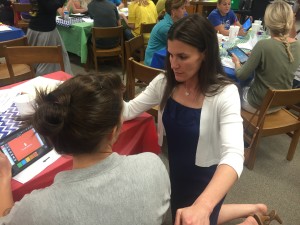 As an instructional coach, one of the most depressing things I see are kids who are bored or declare themselves “done” with school. If you go into primary classrooms, kids are excited about everything they are learning. They’re eager to share, albeit sometimes overly eager, but genuinely excited to gain new information. What is happening to our students as they get older?
As an instructional coach, one of the most depressing things I see are kids who are bored or declare themselves “done” with school. If you go into primary classrooms, kids are excited about everything they are learning. They’re eager to share, albeit sometimes overly eager, but genuinely excited to gain new information. What is happening to our students as they get older?
I think the scary part of that question is that there are multiple answers and some are beyond our control. What is within our control is rejuvenating this love for learning that seems lost as kids grow. The best place to begin is with you, the teacher. Begin by revitalize your passion and enjoyment for what you’re teaching. Try blocking out the outside pressures of limited time, standardized testing, etc. Remind yourself why you’re there and build your enthusiasm. Enthusiasm is contagious. By being genuinely interested in what you’re teaching, your students will have a little more zest themselves.
Here are three ideas that can help reignite your passion:
- Accept change. Education is forever changing, always with good intention, but sometimes misfiring. Ultimately the change is intended to improve student achievement, but the focus is sometimes not delivered well to teachers. When change happens, try taking a deep breath, and ask questions that help you understand the motive behind the change. Dig deep and decide how to make this change occur, mixed with your professional knowledge to help your students. The most important part is to make it work. Complaining and negativity are your biggest enemies.
- Create a Professional Learning Network (PLN). I can’t stress this one enough! Teaching is usually an isolated profession so it is up to you to
 reach out. Visit other teachers in your school, ask questions, initiate professional conversation. Every time I visit a school, I go inside other classrooms and discuss what the teachers like best about their room and teaching. I walk away with fabulous ideas and new thinking. Not only should you create a professional network with the people at your school and district, but you should go global. You have the entire teaching world at your fingers … seriously! The number one profession on twitter is educators! Join them. Twitter isn’t just to find out where Beyonce is having coffee or who Justin Beiber is dating, it is a tool through which professionals share research, tips, and ideas about education. I absolutely LOVE my PLN. Any time I have a question about how to teach something, I pose it on Twitter, and am given so much advice within minutes. Create a PLN to rejuvenate and empower you as you return to your classroom. Literary Fusions does a great half day session to teach educators how to sign up and use twitter professionally. If you’re already on twitter, follow them @LiteraryFusions.
reach out. Visit other teachers in your school, ask questions, initiate professional conversation. Every time I visit a school, I go inside other classrooms and discuss what the teachers like best about their room and teaching. I walk away with fabulous ideas and new thinking. Not only should you create a professional network with the people at your school and district, but you should go global. You have the entire teaching world at your fingers … seriously! The number one profession on twitter is educators! Join them. Twitter isn’t just to find out where Beyonce is having coffee or who Justin Beiber is dating, it is a tool through which professionals share research, tips, and ideas about education. I absolutely LOVE my PLN. Any time I have a question about how to teach something, I pose it on Twitter, and am given so much advice within minutes. Create a PLN to rejuvenate and empower you as you return to your classroom. Literary Fusions does a great half day session to teach educators how to sign up and use twitter professionally. If you’re already on twitter, follow them @LiteraryFusions. - Retrain your brain to a growth mindset. The term “growth mindset” was termed by psychologist Carol Dweck and has slowly been gaining momentum. It truly just means that we are not fixed in what we already know, that with hard work and perseverance we can all gain new knowledge and transform the way we do things. It is important that both teachers and students believe that growth is possible for everyone. This mindset is what will eventually close achievement gaps. If you find yourself next to a teacher with a fixed mindset (you know the ones who say things such as, “these kids are just lazy, they can’t learn anything”) find a new friend! This thought process is poison to your enthusiasm. Not all students are easy to teach and help, but they are all capable of growth. Here is a great website to start you thinking down this path.
What helps you rejuvenate your enthusiasm and love for teaching?


